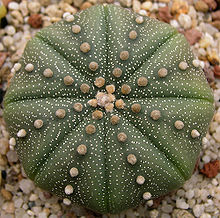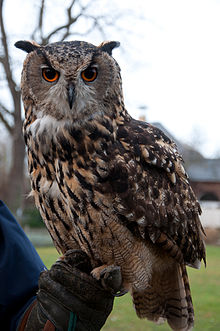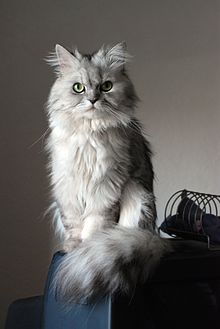- Convergent evolution
-
Convergent evolution 
These two succulent plant genera, Euphorbia
and Astrophytum, are only distantly
related, but have independently converged
on a very similar body form.Convergent evolution describes the acquisition of the same biological trait in unrelated lineages.
The wing is a classic example of convergent evolution in action. Although their last common ancestor did not have wings, both birds and bats do, and are capable of powered flight. The wings are similar in construction, due to the physical constraints imposed upon wing shape. Similarity can also be explained by shared ancestry. Wings were modified from limbs, as evidenced by their bone structure.[1]
Traits arising through convergent evolution are termed analogous structures, in contrast to homologous structures, which have a common origin. Bat and pterosaur wings are an example of analogous structures, while the bat wing is homologous to human and other mammal forearms, sharing an ancestral state despite serving different functions. Similarity in species of different ancestry that is the result of convergent evolution is called homoplasy. The opposite of convergent evolution is divergent evolution, whereby related species evolve different traits. On a molecular level, this can happen due to random mutation unrelated to adaptive changes; see long branch attraction. Convergent evolution is similar to, but distinguishable from, the phenomena of evolutionary relay and parallel evolution. Evolutionary relay describes how independent species acquire similar characteristics through their evolution in similar ecosystems at different times—for example the dorsal fins of extinct ichthyosaurs and sharks. Parallel evolution occurs when two independent species evolve together at the same time in the same ecospace and acquire similar characteristics—for instance extinct browsing-horses and paleotheres.
Contents
Causes
Similarity can also result if organisms occupy similar ecological niches—that is, a distinctive way of life.[2] A classic comparison is between the marsupial fauna of Australia and the placental mammals of the Old World. The two lineages are clades—that is, they each share a common ancestor that belongs to their own group, and are more closely related to one another than to any other clade—but very similar forms evolved in each isolated population.[1] Many body plans, for instance sabre-toothed cats and flying squirrels,[3] evolved independently in both populations.
Distinction from re-evolution
In some cases, it is difficult to tell whether a trait has been lost then re-evolved convergently, or whether a gene has simply been 'switched off' and then re-enabled later. Such a re-emerged trait is called an atavism. From a mathematical standpoint, an unused gene has a reasonable probability of remaining in the genome in a functional state for around 6 million years, but after 10 million years it is almost certain that the gene will no longer function.[4]
Examples
For more details on this topic, see List of examples of convergent evolution.One of the most famous examples of convergent evolution is the camera eye of cephalopods (e.g., squid), vertebrates (e.g., mammals) and cnidaria (e.g., box jellies).[5] Their last common ancestor had at most a very simple photoreceptive spot, but a range of processes led to the progressive refinement of this structure to the advanced camera eye — with one subtle difference: The cephalopod eye is "wired" in the opposite direction, with blood and nerve vessels entering from the back of the retina, rather than the front as in vertebrates.[1] The similarity of the structures in other respects, despite the complex nature of the organ, illustrates how there are some biological challenges (vision) that have an optimal solution.
Parallel vs. convergent evolution
 Evolution at an amino acid position. In each case, the left-hand species changes from incorporating alanine (A) at a specific position within a protein in a hypothetical common ancestor deduced from comparison of sequences of several species, and now incorporates serine (S) in its present-day form. The right-hand species may undergo divergent, parallel, or convergent evolution at this amino acid position relative to that of the first species.
Evolution at an amino acid position. In each case, the left-hand species changes from incorporating alanine (A) at a specific position within a protein in a hypothetical common ancestor deduced from comparison of sequences of several species, and now incorporates serine (S) in its present-day form. The right-hand species may undergo divergent, parallel, or convergent evolution at this amino acid position relative to that of the first species.For a particular trait, proceeding in each of two lineages from a specified ancestor to a later descendant, parallel and convergent evolutionary trends can be strictly defined and clearly distinguished from one another.[6] When both descendants are similar in a particular respect, evolution is defined as parallel if the ancestors considered were also similar, and convergent if they were not.
When the ancestral forms are unspecified or unknown, or the range of traits considered is not clearly specified, the distinction between parallel and convergent evolution becomes more subjective. For instance, the striking example of similar placental and marsupial forms is described by Richard Dawkins in The Blind Watchmaker as a case of convergent evolution, because mammals on each continent had a long evolutionary history prior to the extinction of the dinosaurs under which to accumulate relevant differences. Stephen Jay Gould describes many of the same examples as parallel evolution starting from the common ancestor of all marsupials and placentals. Many evolved similarities can be described in concept as parallel evolution from a remote ancestor, with the exception of those where quite different structures are co-opted to a similar function. For example, consider Mixotricha paradoxa, a microbe that has assembled a system of rows of apparent cilia and basal bodies closely resembling that of ciliates but that are actually smaller symbiont micro-organisms, or the differently oriented tails of fish and whales. On the converse, any case in which lineages do not evolve together at the same time in the same ecospace might be described as convergent evolution at some point in time.
The definition of a trait is crucial in deciding whether a change is seen as divergent, or as parallel or convergent. In the image above, note that, since serine and threonine possess similar structures with an alcohol side-chain, the example marked "divergent" would be termed "parallel" if the amino acids were grouped by similarity instead of being considered individually. As another example, if genes in two species independently become restricted to the same region of the animals through regulation by a certain transcription factor, this may be described as a case of parallel evolution — but examination of the actual DNA sequence will probably show only divergent changes in individual base-pair positions, since a new transcription factor binding site can be added in a wide range of places within the gene with similar effect.
A similar situation occurs considering the homology of morphological structures. For example, many insects possess two pairs of flying wings. In beetles, the first pair of wings is hardened into wing covers with little role in flight, while in flies the second pair of wings is condensed into small halteres used for balance. If the two pairs of wings are considered as interchangeable, homologous structures, this may be described as a parallel reduction in the number of wings, but otherwise the two changes are each divergent changes in one pair of wings.
Similar to convergent evolution, evolutionary relay describes how independent species acquire similar characteristics through their evolution in similar ecosystems, but not at the same time (dorsal fins of sharks and ichthyosaurs).
Significance
Convergence has been associated with Darwinian evolution in the popular imagination since at least the 1940s. For example, Elbert A. Rogers argued that "if we lean toward the theories of Darwin might we not assume that man was [just as] apt to have developed in one continent as another"[7]? The degree to which convergence affects the products of evolution is the subject of a popular controversy. In his book Wonderful Life, Stephen Jay Gould argues that if the tape of life were re-wound and played back, life would have taken a very different course.[8] Simon Conway Morris counters this argument, arguing that convergence is a dominant force in evolution, and that, since the same environmental and physical constraints act on all life, there is an "optimum" body plan that life will inevitably evolve toward, with evolution bound to stumble upon intelligence — a trait of primates, crows, and dolphins - at some point.[1] Convergence is difficult to quantify, so progress on this issue may require exploitation of engineering specifications (e.g., of wing aerodynamics) and comparably rigorous measures of "very different course" in terms of phylogenetic (molecular) distances.
Further reading
- Rasmussen, L.E.L., Lee, T.D., Roelofs, W.L., Zhang, A., Doyle Davies Jr, G. (1996). Insect pheromone in elephants. Nature. 379: 684.
- Convergent Evolution Examples- Ecological Equivalents, Department of Biology, Bellarmine University.
- Stearns, S. & Hoekstra, R. 2005. Evolution: An introduction.
- Lowe, Nancy, "Single Centers of Creation", Southern Spaces, 30 November 2009.
- McMenamin, M.A.S. (1998). The Garden of Ediacara: Discovering the First Complex Life. Columbia University Press.
Footnotes
- ^ a b c d Conway Morris, Simon (2005). Life's solution: inevitable humans in a lonely universe. Cambridge, UK: Cambridge University Press. doi:10.2277/0521827043. ISBN 0-52-160325-0. OCLC 156902715
- ^ Online Biology Glossary.
- ^ Tietjen, = B. "Convergent Evolution Examples – Ecological Equivalents". The Spider Lab: The Internet's True Web Page. Louisville, KY, USA: Bellarmine University Department of Biology. http://cas.bellarmine.edu/tietjen/Evolution/convergent_evolution_examples.htm. Retrieved 2009-03-07
- ^ Collin, R.; Cipriani, R. (2003). "Dollo's law and the re-evolution of shell coiling". Proceedings. Biological sciences / the Royal Society 270 (1533): 2551–2555. doi:10.1098/rspb.2003.2517. PMC 1691546. PMID 14728776. http://www.pubmedcentral.nih.gov/articlerender.fcgi?tool=pmcentrez&artid=1691546.
- ^ Kozmik, Z.; Ruzickova, J.; Jonasova, K.; Matsumoto, Y.; Vopalensky, P.; Kozmikova, I.; Strnad, H.; Kawamura, S. et al. (Jul 2008). "Assembly of the cnidarian camera-type eye from vertebrate-like components" (Free full text). Proceedings of the National Academy of Sciences of the United States of America 105 (26): 8989–8993. Bibcode 2008PNAS..105.8989K. doi:10.1073/pnas.0800388105. ISSN 0027-8424. PMC 2449352. PMID 18577593. http://www.pnas.org/cgi/pmidlookup?view=long&pmid=18577593.
- ^ Zhang, J. and Kumar, S. 1997. Detection of convergent and parallel evolution at the amino acid sequence level. Mol. Biol. Evol. 14, 527-36.
- ^ Rogers, E. A. 1943. "Who knows?" Hobbies—The Magazine for Collectors, June 1943, p. 101.
- ^ Gould, S.J. (1989). Wonderful Life: The Burgess Shale and the Nature of History. W.W. Norton & Company.
Evolutionary ecology Patterns of evolution Signals Categories:
Wikimedia Foundation. 2010.



